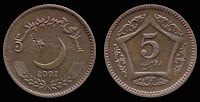Pattern Coin is a coin which has not been approved for release, produced for the purpose of evaluating a proposed coin design. They are often off-metal strike, to proof standard or piedforts. They are collected or studied by many coin collectors because of their sometimes highly elaborate designs.
In Pakistan Mint’s history, they are consistently producing prototype or “pattern” coins to test various designs, metals, formats and techniques. Some examples of Pakistan Pattern Coins are
In Pakistan Mint’s history, they are consistently producing prototype or “pattern” coins to test various designs, metals, formats and techniques. Some examples of Pakistan Pattern Coins are
3 Paisa (1966) 1 Paisa Bronze (1967)
5 Paisa Aluminum (1971) 1 Rupee Nickel Brass (1991)
5 Paisa ND
10 Paisa ND 50 Paisa ND
1 Rupee Bronze (1995) 50 Rupees Bronze (1995)
5 Rupees Silver (1995) 5 Rupees Silver Double Strike
5 Rupees Pattern (1995) 5 Rupees Pattern (1995)
50 Rupees Pattern (1997) 50 Rupees Bronze (1997)
50 Rupees Pattern (1997)
25 Paisa Aluminum (1998) 50 Paisa Brass (1998)
5 Rupees Pattern (2001) 5 Rupees Pattern (2001)
5 Rupees Pattern (2001) 5 Rupees Pattern (2001)
5 Rupees Pattern (2001) 5 Rupees Pattern (2001)
5 Rupees Pattern (2001) 5 Rupees Pattern (2001)
5 Rupees Copper (2002) 5 Rupees Copper Zinc (2002)
10 Rupees Bronze (2003)
10 Rupees Bronze (2008) 10 Rupees Brass (2008)





















































